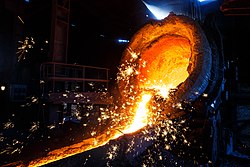 Global Information
Global InformationWrought iron information
| Steels |
|---|
 |
| Phases |
|
| Microstructures |
|
| Classes |
|
| Other iron-based materials |
|
Wrought iron is an iron alloy with a very low carbon content (less than 0.05%) in contrast to that of cast iron (2.1% to 4.5%). It is a semi-fused mass of iron with fibrous slag inclusions (up to 2% by weight), which give it a wood-like "grain" that is visible when it is etched, rusted, or bent to failure. Wrought iron is tough, malleable, ductile, corrosion resistant, and easily forge welded, but is more difficult to weld electrically.
Before the development of effective methods of steelmaking and the availability of large quantities of steel, wrought iron was the most common form of malleable iron. It was given the name wrought because it was hammered, rolled, or otherwise worked while hot enough to expel molten slag. The modern functional equivalent of wrought iron is mild steel, also called low-carbon steel. Neither wrought iron nor mild steel contain enough carbon to be hardened by heating and quenching,[1]: 145 [failed verification] but true wrought iron is much more corrosion-resistant.[citation needed]
Wrought iron is highly refined, with a small amount of silicate slag forged out into fibers. It comprises around 99.4% iron by mass.[2] The presence of slag can be beneficial for blacksmithing operations, such as forge welding, since the silicate inclusions act as a flux and give the material its unique, fibrous structure.[3] The silicate filaments in the slag also protect the iron from corrosion and diminish the effect of fatigue caused by shock and vibration.[4]
Historically, a modest amount of wrought iron was refined into steel, which was used mainly to produce swords, cutlery, chisels, axes, and other edged tools, as well as springs and files. The demand for wrought iron reached its peak in the 1860s, being in high demand for ironclad warships and railway use. However, as properties such as brittleness of mild steel improved with better ferrous metallurgy and as steel became less costly to make thanks to the Bessemer process and the Siemens–Martin process, the use of wrought iron declined.
Many items, before they came to be made of mild steel, were produced from wrought iron, including rivets, nails, wire, chains, rails, railway couplings, water and steam pipes, nuts, bolts, horseshoes, handrails, wagon tires, straps for timber roof trusses, and ornamental ironwork, among many other things.[5][note 1]
Wrought iron is no longer produced on a commercial scale. Many products described as wrought iron, such as guard rails, garden furniture,[6] and gates are made of mild steel.[7] They are described as "wrought iron" only because they have been made to resemble objects which in the past were wrought (worked) by hand by a blacksmith (although many decorative iron objects, including fences and gates, were often cast rather than wrought).[7]
- ^ Tylecote, R.F. (1992). A History of Metallurgy (Second ed.). London: Maney Publishing, for the Institute of Materials. ISBN 978-0901462886.
- ^ "Wrought Iron – Properties, Applications". Azom.com. AZoNetwork. 13 August 2013. Retrieved 27 October 2019.
- ^ Alex Walter (31 October 2018). "What is wrought iron?". Mechanical Site. Archived from the original on 27 October 2019. Retrieved 27 October 2019.
- ^ "What is wrought iron?". Iron Gates N Railings Ltd. 2017. Archived from the original on 7 February 2023. Retrieved 27 October 2019.
- ^ a b Gordon, Robert B. (1996). American Iron 1607–1900. Baltimore and London: Johns Hopkins University Press. ISBN 0-8018-6816-5.
- ^ "Wrought Iron: A Patio Furniture dream". cnet reviews. Archived from the original on 23 January 2010. Retrieved 29 September 2009.
- ^ a b Daniel, Todd. "Clearing the Confusion Over Wrought Iron". Fabricator. No. November/December 1993. NOMMA. p. 38. Archived from the original on 2020-11-24. Retrieved 2019-10-27.
Cite error: There are <ref group=note> tags on this page, but the references will not show without a {{reflist|group=note}} template (see the help page).



